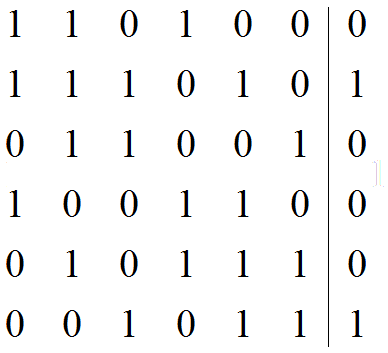*POJ 1222 高斯消元
| Time Limit: 1000MS | Memory Limit: 10000K | |
| Total Submissions: 9612 | Accepted: 6246 |
Description

The aim of the game is, starting from any initial set of lights on
in the display, to press buttons to get the display to a state where all
lights are off. When adjacent buttons are pressed, the action of one
button can undo the effect of another. For instance, in the display
below, pressing buttons marked X in the left display results in the
right display.Note that the buttons in row 2 column 3 and row 2 column 5
both change the state of the button in row 2 column 4,so that, in the
end, its state is unchanged.

Note:
1. It does not matter what order the buttons are pressed.
2. If a button is pressed a second time, it exactly cancels the
effect of the first press, so no button ever need be pressed more than
once.
3. As illustrated in the second diagram, all the lights in the first
row may be turned off, by pressing the corresponding buttons in the
second row. By repeating this process in each row, all the lights in the
first
four rows may be turned out. Similarly, by pressing buttons in
columns 2, 3 ?, all lights in the first 5 columns may be turned off.
Write a program to solve the puzzle.
Input
first line of the input is a positive integer n which is the number of
puzzles that follow. Each puzzle will be five lines, each of which has
six 0 or 1 separated by one or more spaces. A 0 indicates that the light
is off, while a 1 indicates that the light is on initially.
Output
each puzzle, the output consists of a line with the string: "PUZZLE
#m", where m is the index of the puzzle in the input file. Following
that line, is a puzzle-like display (in the same format as the input) .
In this case, 1's indicate buttons that must be pressed to solve the
puzzle, while 0 indicate buttons, which are not pressed. There should be
exactly one space between each 0 or 1 in the output puzzle-like
display.
Sample Input
2
0 1 1 0 1 0
1 0 0 1 1 1
0 0 1 0 0 1
1 0 0 1 0 1
0 1 1 1 0 0
0 0 1 0 1 0
1 0 1 0 1 1
0 0 1 0 1 1
1 0 1 1 0 0
0 1 0 1 0 0
Sample Output
PUZZLE #1
1 0 1 0 0 1
1 1 0 1 0 1
0 0 1 0 1 1
1 0 0 1 0 0
0 1 0 0 0 0
PUZZLE #2
1 0 0 1 1 1
1 1 0 0 0 0
0 0 0 1 0 0
1 1 0 1 0 1
1 0 1 1 0 1
Source
题意:
有5行6列共30个开关,每按动一个开关,该开关及其上下左右共5个开关的状态都会改变,初始给你这30个开关的状态求按动那些开关能够使这些开关的状态都是0.
思路:因为每盏灯,如果操作两次就相当于没有操作,所以相当于(操作次数)%2,即异或操作。
考虑一个2*3的图,最后需要的状态是 : ,如果初始状态为:
,如果初始状态为: 。对这两个矩阵的每个数字做异或操作可以得到线性方程组每个方程的答案。
。对这两个矩阵的每个数字做异或操作可以得到线性方程组每个方程的答案。
总共6盏灯,0-5。那么可以列出6个方程。
对于第0盏灯,会影响到它的是第0, 1, 3盏灯,因此可以列出方程1*x0 + 1*x1 + 0*x2 + 1*x3 + 0*x4 + 0*x5= 0。
对于第1盏灯,会影响到它的是第0, 1, 2,4盏灯,因此可以列出方程1*x0 + 1*x1 + 1*x2 + 0*x3 + 1*x4 + 0*x5 = 1。
对于第2盏灯,会影响到它的是第1, 2, 5盏灯,因此可以列出方程0*x0 + 1*x1 + 1*x2 + 0*x3 + 0*x4 + 1*x5 = 0。
.....
所以最后可以列出增广矩阵:
然后用高斯消元求这个矩阵的解就可以了。
30个变量30个方程组
代码:
#include<iostream>
#include<cstdio>
#include<cstring>
#include<cmath>
using namespace std;
const int MAX=;
int a[MAX][MAX]; //增广矩阵
int x[MAX]; //解集
int equ,var; //行数和列数
void init()
{
equ=;var=;
memset(a,,sizeof(a));
for(int i=;i<;i++) //t点和上下左右都改变
for(int j=;j<;j++)
{
int t=*i+j;
a[t][t]=;
if(i>) a[*(i-)+j][t]=;
if(i<) a[*(i+)+j][t]=;
if(j>) a[t-][t]=;
if(j<) a[t+][t]=;
}
}
void gaos()
{
int maxr;
for(int k=,col=;k<equ&&col<var;k++,col++)
{
maxr=k; /****变为行阶梯形矩阵***/
for(int i=k+;i<equ;i++)
if(abs(a[i][col])>abs(a[maxr][col]))
maxr=i;
if(maxr!=k)
{
for(int i=col;i<var+;i++)
swap(a[maxr][i],a[k][i]);
}
if(a[k][col]==) //第k行后的第col列全部是0了,换下一列
{
k--;
continue;
}
for(int i=k+;i<equ;i++) //第k行减去第i行的值赋给第i行,变为行阶梯型矩阵,由于都是01型矩阵,不用找lcm直接减就行
{
if(a[i][col]!=)
{
for(int j=col;j<var+;j++)
a[i][j]^=a[k][j];
}
}
for(int i=var-;i>=;i--) //算出解集
{
x[i]=a[i][var];
for(int j=i+;j<var;j++) //该行第var列是1说明该行有且只有一个x取1,若为0说明没有取1的x.
x[i]^=(a[i][j]&x[j]);
}
}
}
int main()
{
int t,ca=;
scanf("%d",&t);
while(t--)
{
ca++;
init();
for(int i=;i<;i++)
scanf("%d",&a[i][]);
gaos();
printf("PUZZLE #%d",ca);
for(int i=;i<;i++)
{
if(i%==) printf("\n%d",x[i]);
else printf(" %d",x[i]);
}
printf("\n");
}
return ;
}
*POJ 1222 高斯消元的更多相关文章
- POJ 1222 高斯消元更稳
大致题意: 有5*6个灯,每个灯只有亮和灭两种状态,分别用1和0表示.按下一盏灯的按钮,这盏灯包括它周围的四盏灯都会改变状态,0变成1,1变成0.现在给出5*6的矩阵代表当前状态,求一个能全部使灯灭的 ...
- POJ 1222 POJ 1830 POJ 1681 POJ 1753 POJ 3185 高斯消元求解一类开关问题
http://poj.org/problem?id=1222 http://poj.org/problem?id=1830 http://poj.org/problem?id=1681 http:// ...
- POJ SETI 高斯消元 + 费马小定理
http://poj.org/problem?id=2065 题目是要求 如果str[i] = '*'那就是等于0 求这n条方程在%p下的解. 我看了网上的题解说是高斯消元 + 扩展欧几里德. 然后我 ...
- POJ 2065 高斯消元求解问题
题目大意: f[k] = ∑a[i]*k^i % p 每一个f[k]的值就是字符串上第 k 个元素映射的值,*代表f[k] = 0 , 字母代表f[k] = str[i]-'a'+1 把每一个k^i求 ...
- poj 2065 高斯消元(取模的方程组)
SETI Time Limit: 1000MS Memory Limit: 30000K Total Submissions: 1735 Accepted: 1085 Description ...
- POJ 1681 高斯消元 枚举自由变元
题目和poj1222差不多,但是解法有一定区别,1222只要求出任意一解,而本题需要求出最少翻转次数.所以需要枚举自由变元,变元数量为n,则枚举的次数为1<<n次 #include < ...
- POJ 1830 高斯消元
开关问题 Description 有N个相同的开关,每个开关都与某些开关有着联系,每当你打开或者关闭某个开关的时候,其他的与此开关相关联的开关也会相应地发生变化,即这些相联系的开关的状态如果原来为 ...
- POJ 1222 EXTENDED LIGHTS OUT(高斯消元)题解
题意:5*6的格子,你翻一个地方,那么这个地方和上下左右的格子都会翻面,要求把所有为1的格子翻成0,输出一个5*6的矩阵,把要翻的赋值1,不翻的0,每个格子只翻1次 思路:poj 1222 高斯消元详 ...
- Gym 100008E Harmonious Matrices 高斯消元
POJ 1222 高斯消元更稳 看这个就懂了 #include <bits/stdc++.h> using namespace std; const int maxn = 2000; in ...
随机推荐
- 第二天--html
<!DOCTYPE html><!--设置文档类型为标准的html5模型--><html> <head> <meta char ...
- Java算法之递归打破及在真实项目中的使用实例
开心一笑 刚才领导问开发:"你觉得这个项目的最大风险是什么",开发说:"加班猝死" , 气氛尴尬了一分钟!!! 提出问题 1.递归算法简单复习 2.如何实现递归 ...
- javascript中的预编译问题
Js作为脚本语言,可以不需要编译直接运行,但遇到类似变量或者函数同名,预编译方面的知识可以帮助我们更好解决问题. 示例: 这是一段js中普通的函数调用代码 <script>1. // ...
- request:getParameter getAttribute
转载自:http://www.cnblogs.com/shaohz2014/p/3804656.html 在浏览器地址输入,表示传入一个参数test,值为123 http://localhost:88 ...
- git push 报错!!!!
[root@NB sh]# git push To git@x0.xx.xxx.x1:yanjing_chenl/IT-DOC.git ! [rejected] master -> master ...
- jQuery对象与dom对象相互转换
核心提示:jquery选择器得到的jquery对象和标准的 javascript中的document.getElementById()取得的dom对象是两种不同的对象类型,一般情况下,如S('#id' ...
- 分享一个分布式消息总线,基于.NET Socket Tcp的发布-订阅框架,附代码下载
一.分布式消息总线 在很多MIS项目之中都有这样的需求,需要一个及时.高效的的通知机制,即比如当使用者A完成了任务X,就需要立即告知使用者B任务X已经完成,在通常的情况下,开发人中都是在使用者B所使用 ...
- 再探JS数组原生方法—没想到你是这样的数组
最近作死又去做了一遍javascript-puzzlers上的44道变态题,这些题号称"JS语言专业八级"的水准,建议可以去试试,这里我不去解析这44道题了, ...
- POJ 2718 Smallest Difference【DFS】
题意: 就是说给你一些数,然后要求你使用这些数字组成2个数,然后求他们的差值最小. 思路: 我用的双重DFS做的,速度还比较快,其中有一个很重要的剪枝,若当前搜索的第二个数后面全部补零与第一个数所产生 ...
- EF中扩展出Between操作符 (修订版)
随手记录一下,这是针对原文错误的修改. 原文:EF中扩展出Between操作符 直接使用是错误的,修改后的扩展方法: /// <summary> /// 扩展 Between 操作符 // ...
